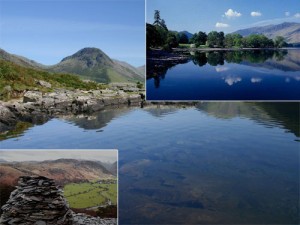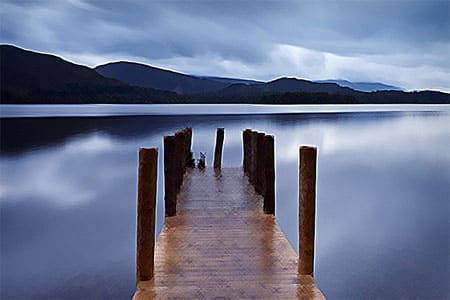One of the great treasures of England is tucked away in the North-West of the country – the picturesque mountains, lush valleys, rocky peaks, moorlands and lakes, known collectively as the Lake District. Located entirely within the modern English county of Cumbria, and easily accessible by trunk roads, rail and ferry, “The Lakes” as they are commonly known, have been a popular tourist destination since the 17th century and have given inspiration to countless painters, writers and poets, most memorably William Wordsworth and Beatrix Potter. Others make the trip to enjoy the legendary Castlerigg Stones, an ancient circle of 38 stones made even more strikingly spectacular as they are entirely ringed by mountains to the north, south, west and east. Today, the area attracts a wide variety of visitors, from those seeking associations with great art and literature, to hikers, nature and wildlife enthusiasts, and those simply seeking the joy and serenity of one of the most beautiful areas in Europe.
Against the backdrop of mountains and rocky fells – Old Norse for “mountains” – lie the jewels of the district – the 14 lakes themselves. Amongst them are Lake Wastwater, the deepest lake in England, and Lake Windermere, the longest. The Lake District, officially a National Park, also has the distinction of being home to the only parts of England that are higher than 3,000 feet above sea level, including Scafell Pike, the highest mountain in England. Between the peaks are valleys of bracken and heather, forests and moorland. Wildlife flourishes, including several species unique in the country. These include the red squirrel, the country’s only Golden Eagles, and the Herdwick – a breed of sheep native to the Lake District. The pristine aspect of the area has been preserved through the centuries, despite human settlements. Today, most of those towns and villages in the district are directly involved in tourism, providing lodgings, meals, tours, guides and a plethora of information on the history and the natural wonders of the area.
As they have done since the mid-19th-century, many visitors to the Lake District are in search of places and sights associated with the poet William Wordsworth, who composed some of his most beloved works, including “Daffodils”, while residing at Dove Cottage, Grasmere. They also come to pay homage at the Beatrix Potter House. Potter made her home in the district, at Hill House by the shores of Lake Windermere, where the woods and wildlife provided the inspiration for her inimitable characters. In the 20th century, Sir Hugh Walpole so fell in love with the Lake District that he bought a house, Brackenburn, overlooking the Derwentwater Lake, and wrote a large number of his works while living there. Inspired by both past and present, modern-day artists and writers are among the most enthusiastic visitors to the Lake District, and can be seen, perched on an outcrop or settled by a lake, writing and painting as their predecessors have done for centuries.
Historically, the Lake District encompassed three counties – Cumberland, Westmorland and Lancashire. Today, however, the area is part of Cumbria, and sometimes known as the Cumbrian Mountains. It is easily accessible by highways and good roads, and driving tours are extremely popular. To the east lies the M6 motorway and other key roads cut across the district to the north and south, as well as from the coastal plains to the west. The A590 connects the M6 to the  Lake District’s major town, Barrow-in-Furness. Three rail lines skirt the perimeter of the district, the West Coast Main Line, the Cumbrian Coast Line and the Windermere Branch Line. There are also narrow gauge railway links that connect tourists from the West coast with towns and hamlets within the Lake District and a small line, the Lakeside and Haverthwaite Railway that connects villages and tourists with a passenger ferry. For drivers, there is a vehicle-carrying ferry to take them across Lake Windermere and seasonal ferries on other lakes.
Lake District’s major town, Barrow-in-Furness. Three rail lines skirt the perimeter of the district, the West Coast Main Line, the Cumbrian Coast Line and the Windermere Branch Line. There are also narrow gauge railway links that connect tourists from the West coast with towns and hamlets within the Lake District and a small line, the Lakeside and Haverthwaite Railway that connects villages and tourists with a passenger ferry. For drivers, there is a vehicle-carrying ferry to take them across Lake Windermere and seasonal ferries on other lakes.
Within the Lake District National Park, visitors will find accommodations to suit any taste and pocket: Hotels, cozy cottages (including self-catering), bed-and-breakfasts, inns, and campsites – even hostels and barns! Whether looking for a charming English village, or a rustic retreat, the visitor will find a place to stay that provides the right ambience. A good place to start planning a Lake District vacation is at the official Cumbrian tourism website https://www.golakes.co.uk/. Spring and summer are the best times to visit, especially if visitors hope to explore some of the more remote trails and walks. Many visitors tend to combine a visit to the Lake District with other northern English attractions, and there is a useful map showing the proximity of the Lake District to other areas of interest at https://www.picturesofengland.com/nationalparks. The Pictures of England site also has lots of information for those who wish to explore other historic or picturesque parts of England as well. Google maps also offer an excellent map of England and all its regions.
